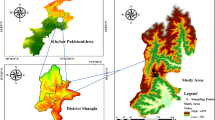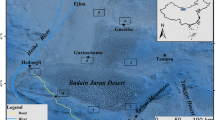Abstract
In order to identify factors affecting the distribution of Anabasis aphylla in rangelands of Iran, 132 climatic parameters which contributed to the species distribution (based on the ecological conditions of the study area) were selected. Factor analysis was then applied to determine the most important factors affecting species distribution. In the next stage, the spatial distribution map of An. aphylla throughout Iran was prepared. According to the results of factor analysis, ten factors with Eigenvalues greater than one explained 92.96% of the total variance. These factors were temperature below zero, winter rainfall, summer rainfall, wind, sunlight, warm season dust, rainfall in fall, thunderstorms, relative humidity in September, and cloudy days in winter and explained 34.34, 9.71, 9.69, 8.85, 5.99, 5.35, 4.97, 4.78, 4.73, and 4.51% of the total variance, respectively. Moreover, six vegetation types containing An. aphylla were identified throughout the country. These types were distributed in the central areas of Iran and also in patches within the southeastern parts of the country. The results showed that in addition to the nine above climatic factors, soil variables particularly salinity influence establishing the vegetation types in their distribution areas and the vegetation types are located in low to relatively high salinity, and soils with these salinity levels (low to relatively high salinity) are suitable for these types of plants.













Similar content being viewed by others
References
Abd El-Ghani MM, El-Sawaf NA (2005) The coastal roadside vegetation and environmental gradients in the arid lands of Egypt. Comm Ecol 6:143–154
Ajabnoor MA, Al-Ayah A, Tarq M, Jayyab AA (1984) Antidiabetic activity of Hamda salicorica. Fitoterapia 40(2):107-109
Akhani A (2006) Flora Iranica: facts and figures and a list of publications by K. H rechinger on Iran and adjacent areas. Rostaniha 7(2):19–61
Asri Y (1998) The vegetation of salt Lake Uremia, Research Institute of forest and rangelands, 222(1)19-38
Barakat NA, Laudadio V, Cazzato E, Tufarelli V (2013) Potential contribution of Retama raetam (Forssk.) Webb & Berthel as a forage shrub in Sinai, Egypt. Arid Land Res Manag 27(3):257–271
Barakat NAM, El-Gawad AMA, Laudadio V, Kabiel HF, Tufarelli V, Cazzato E (2014) A contribution to the ecology and floristic markers of plant associations in different habitats of Sinai peninsula, Egypt. Rendiconti Lincei 25(4):479–490
Bui EN, Henderson BL (2003) Vegetation indicators of salinity in northern Queensland. Aust Ecol 28:539–552
Farshadfar E (2001) Principles and multivariate statistical method, Taghe Boston publication. Kermanshah razi university, Kermanshah
Gavilán RG (2005) The use of climatic parameters and indices in vegetation distribution. A case study in the Spanish Sistema Central. Int J Biometeorol 50(2):111–120
Ghadaki MB, Van Soest PJ, Dowell REMC, Malekpour B (1974) Composition and in vitro digestibility of rangeland grasses, legumes, forbs and shrub plants in Iran. Cornell University, Ithaca, 15p
Heidari sharifabad H (2007) Salinity stress, the first Conference of Environmental stress on plants, Shahed University of Tehran, Iran
Hossel JE, Riding AE, Brown I (2003) The creation and characterization a bioclimatic classification for Britain and Ireland. J Nat Conserv 11:5–13
Iran Meteorological Organization (2016) Data set of meteorological from 1951 to 2010
Iran’s Forests, Range, and Watershed Management Organization (2016) Vegetation map of Iran containing dominant species plant types
Jafarpour A (1992) Climatology. Tehran University Publication, Tehran, 382p
Jin-Tun Z (2002) A study on relation of vegetation, climate and soil in Shanxi province. J Plant Ecol 162:23–31
Khodagholi M (2005) The survey of bio climate vegetation in zayande rood basin in Iran. PhD thesis in Isfahan University, Iran
Klink K, Wiersma JJ, Crawford CHJ, Deon S (2013) Impacts of temperature and precipitation variability in the Northern Plains of the United States and Canada on the productivity of spring barley and oat. Int J Climatol 34(8):2805–2818
Knapp A k, Fay PA, Blair JM, Collins SL, Smith MD, Carlisle JD, Harper CW, Danner BT, Lett MS, McCarron JK (2002) Rainfall variability, carbon cycling, and plant species diversity in a Mesic grassland. Science 298:2202–2205
Moghaddam M (2001) Descriptive and statistical ecology. Tehran University Publication, Tehran, 285p
Momeni A (2010) Geographical distribution and levels of soil salinity in Iran. J Soil Res 24(3)
Mossa JS (1985) A study on the crude antidiabetic drugs used in Arabian folk medicine. Int J Crude Drug Res 23(3):137–142
Mankolli H, Cekani M, Abazi U, Kopali A (2009) Bioclimatic classifications in the ecosystem of Dajt-Tirana, Albania. J Int Environ Appl Sci 4(1):119–124
Moral FJ, Rebollo FJ Paniagua LL, Garcia A (2014) Climatic spatial variability in Extremadura (Spain) based on viticulture bioclimatic indices. Int J Biol Sci
Pabot H (1967) Report to the government of Iran on pasture development and range improvement through botanical and ecological studies. Iran Ministry of natural resources,Tehran,Iran
Prasad VK, Badarinath KVS, Anuradha E (2008) Effects of precipitation, temperature and topographic parameters on evergreen vegetation greenery in the western Ghats. India Int J Climatol 28:1807–1819
Rogel JA, Silla RO, Ariza FA (2001) Edaphic characterization and soil ionic composition influencing plant zonation in a semiarid Mediterranean salt marsh. Geoderma 99:81–98
Sabeti H (1975) Iran critical climates. Tehran university publication, Tehran
Saboohi R, Khodagholi M (2013) Effect of climatic factors on distribution of Bromus Tommentellus in Isfahan province. J Appl Ecol (4):57–71
Tatian MR (2001) Phytosociology of Hezarjarib summer rangelands in Behshahr. M.Sc. Thesis, Faculty of Natural Resources. Mazandaran University. 127PP. (in Persian).
Tao J, Zhang Y, Dong J, Fu Y, Zhu J, Zhang G, Jiang Y, Tian l, Zhang X, Zhang T, Yi X (2014) Elevation-dependent relationships between climate change and grassland vegetation variation across the Qinghai-Xizang plateau. Int J Climatol 35(7):1638–1647
Yaghmaei L, Khodagholi M, Soltani S, Saboohi R (2009) Effect of bioclimatic factors on distribution of forest types in chaharmahal & bakhtiari province using factor analysis. Iran J For 239(2):251–261
Zare Chahooki MA (2001) Investigation of relationship between some rangeland species and some of soil physicochemical properties in Poshtkooh rangelands, Yazd. M.Sc. Thesis, Faculty of Natural Resources. Tehran University. 123PP. (in Persian)
Ziatabar M, Raeeni M (1995) Climate and vegetation distribution. Mazandaran University Publication, Mazandaran, Iran
Author information
Authors and Affiliations
Corresponding author
Rights and permissions
About this article
Cite this article
Khatibi, R., Soltani, S. & Khodagholi, M. Effects of climatic factors and soil salinity on the distribution of vegetation types containing Anabasis aphylla in Iran: a multivariate factor analysis. Arab J Geosci 10, 36 (2017). https://doi.org/10.1007/s12517-016-2812-0
Received:
Accepted:
Published:
DOI: https://doi.org/10.1007/s12517-016-2812-0




